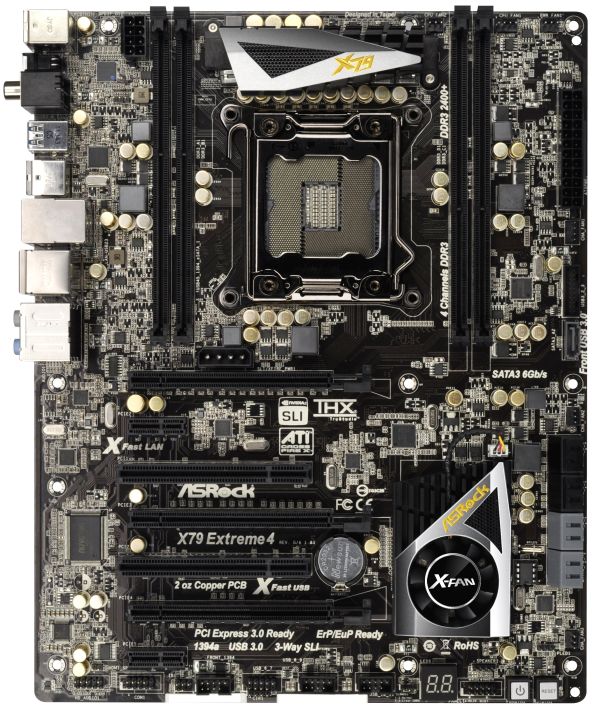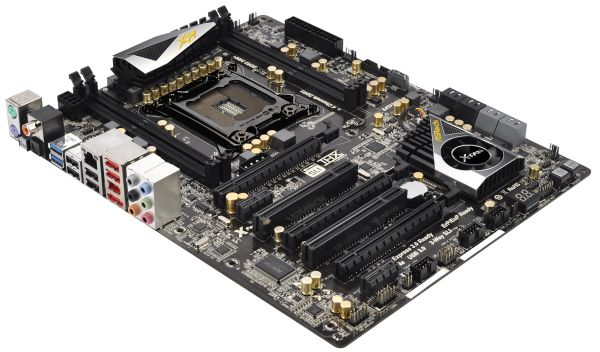ASRock X79 Extreme4-M and X79 Extreme4 Review – Sandy Bridge-E meets mATX
by Ian Cutress on December 9, 2011 12:00 PM EST- Posted in
- Motherboards
- ASRock
- X79
Overview
One of the first things people notice about the X79 Extreme4 is the price – a full size ATX board with the X79 chipset for ~$235 MSRP. As I mentioned in the X79 Extreme4-M overview, there will be demand for such cheap motherboards when more mainstream enthusiasts (rather than pure enthusiasts) may consider spending some, but not a lot, of money on a Sandy Bridge-E system.
With the ATX size, we can take full advantage of all the X79 features. In comparison to the X79 Extreme4-M, there is no lack of space for 40 PCIe lanes between the PCIe slots, there are more SATA 6 Gbps ports, the package has more to it (SATA cables, SLI connectors), and the board is tri-GPU possible. Some users may not like the fact that it has four memory slots (one per channel), but that is part of the reason why the board is cheaper than others. I will touch on this in the conclusion at the end of the review.
Performance on the whole was not too dissimilar to the X79 Extreme4-M, as expected. There were certain tests that this board would be slightly better on, and vice versa, but nothing outside the realms of statistical variance. Like the 4-M, despite the Realtek ALC898 audio, DPC Latency was a bit lacking compared to other X79 boards tested so far since release, probably due to BIOS configurations and maturity. The XFast LAN results however, as with Sandy Bridge P67/Z68 iterations, were a cut above the rest.
Visual Inspection
Perhaps it is just me, but I am starting to like the new ASRock styling. The black and gold angular PCH/heatsink style works quite well in my view of a top of the range motherboard, even if this is the more financially realistic end of X79 for the majority of users.
Despite the ability of having eight memory slots on X79, ASRock have decided to reduce the board price by only using one DIMM per channel, meaning four memory slots in total, here with quick release connectors. Given the abundance and low price of 4 GB DDR3 modules recently, and few power users requiring more than 16 GB of memory, using 4 DIMM slots is a good representation to save a few dollars on an overall system build perhaps. We will not be seeing all four memory slots on one side though, due to the pin layout of SB-E. As a result, the power solution to X79 boards are going to be squashed in the area above the socket itself – we see here ASRock have a heatsink covering the 6+2 phase VRM and chokes. A few vendors have this heatsink connected to a heatpipe and another heatsink below the socket, but again ASRock have left this out to save a few pennies.
Fan headers are in abundance, with a total of six. Two CPU headers and a PWR header on the top right, and a chassis header is underneath the 24-pin ATX power connector. Another chassis header is above the main block of SATA ports (which gets completely obstructed by any full length GPU in the first PCIe slot, and a third chassis header below the SATA ports (again, obstructed when a third full length GPU is in use).
Beneath the 24-pin ATX power connector is a USB 3.0 header, and a SATA 6 Gbps port, both provided by ASMedia controllers. The main block of SATA ports contains the typical ports from the Platform Controller Hub (four SATA 3Gbps in black, two SATA 6Gbps in gray), and another two SATA 6 Gbps provided via a controller. Next to this is the PCH itself covered in a black, gold and silver heatsink. As the heatsink is relatively small, ASRock have included a small fan connected to a small onboard header. This fan isn’t set to come on (by default) until the PCH reaches 50 degrees Celsius.
Despite this being one of the cheaper X79 options, we still get power/reset buttons, along with a two-digit debug LED useful for recognizing board issues. Aside from the usual array of headers on the bottom of the board, people will note the colorful use of gold capacitors on the board to tie in with the black/gold theme. ASRock argue in their marketing that these are premium conductive polymer caps – I hope they’re in some way premium, with this being X79.
In terms of PCIe layout, we have good and negative points. At the top is a 4-pin molex connector designed to give the PCIe extra power. For all intents and purposes, I found this largely useless, as two GTX580 GPUs ran quite happily without issue, as they already have their own power connectors and the PCIe specification should provide more power through the slot. It is also in an awkward place, for cable management inside a case. Nevertheless, we cannot really poke holes in the PCIe layout – at the top is a PCIe x16, x1, PCI, x16, PCI, x8, x1. I am thankful for the triple slot gap between the first two GPU x16 slots, and there is some space for any PCIe x1 card at the bottom. This is slightly different to what we normally see when PCIe lanes are at a premium – normally the x1 is at the top.
The back panel layout is identical to the X79 Extreme4-M. To quote, ‘From left to right, we see two PS/2 connectors, a clear CMOS button, a coaxial SPDIF out, an optical SPDIF out, two USB 3.0 ports, six USB 2.0 ports, gigabit Ethernet (Broadcom BCM57781), eSATA 6 Gbps, FireWire, and audio headers. For a board this price and on X79, we do not see much extra from what we would expect to be the standard.’












54 Comments
View All Comments
unixfg - Sunday, December 11, 2011 - link
Maybe you could explain why you think they're wrong rather than just calling them names. They seem to be pretty much right-on regarding the point of having swap/pagefile on disk.twoBitBasher - Friday, December 9, 2011 - link
You guys surely must have got more modern drives lying around, especially when Anand is constantly reviewing the bleeding edge!I would have liked to see what this board can do. It is for enthusiasts after all, isn't it?
DanNeely - Friday, December 9, 2011 - link
Benchmark platforms can't change rapidly. When they do you can no longer compare new scores to old. As a result the parts not being compared typically don't get swapped out until obsolete.Thrawn7 - Saturday, December 10, 2011 - link
I don't consider the thermal throttle to be a bad thing at all. Throttling at 80c+ temperatures is good behaviour. Its a better guarantee for stability when you either have a cooling failure or are too lazy to have good cooling in the first place.Clearly these Sandy-E is the hottest overclocking chips ever from Intel.
Basically, to overclock to the typical 4.7 Ghz range the Intel liquid cooling solution is insufficient. Not that surprising given the performance of that is probably about the same as a mid-range $40 120mm heatsink soluiton.
To do a decent overclock you'll need a H100 or Noctua D14 at fairly high rpms or better still a real watercool loop.
etamin - Saturday, December 10, 2011 - link
I was very impressed with the new ASRock color scheme and heatsink design....until the gratuitous use of "X" labeling distracted me. What a shame. (no need to read review now, it's too ugly to consider buying)karma77police - Saturday, December 10, 2011 - link
ASRock released BIOS update few days ago for Extreme4 version 1.60 and for Extreme4M version 1.50, which let's you overclock CPU 4.6Ghz for example with very low voltage. They updated C-2 Microcode etc. I am running i7 i3930k on ASRock Extreme 4 with < 1.36V. Temperature does not exceed 60C in Load. I always say reviews are so misleading when it comes to decide what purchase to make.karma77police - Saturday, December 10, 2011 - link
4.5Ghz with < 1.36VEJ257 - Saturday, December 10, 2011 - link
The chart say 6xDDR3 slots. Is that a typo or is that actually how it's setup?etamin - Sunday, December 11, 2011 - link
Yeah, that's strange for X79. But it is 6. There is also a photo of it on the ASRock site.Ryomitomo - Monday, December 12, 2011 - link
Asus also released USB Boost, which is similar to Asrock USB XFast. I'd like to see USB Boost vs USB XFast in future reviews.